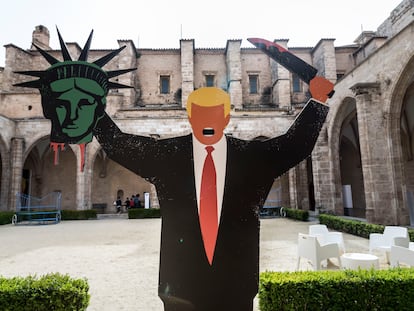George Grosz, a degenerate in Berlin
The city pays a debt of gratitude to the great German painter and chronicler of the first half of the 20th century, a communist who was loathed by the Nazis, by dedicating a museum to him

For a city like Berlin, home to museums of all kinds (with a variety of themes ranging from lipstick to the actor Bud Spencer) and institutions devoted to local creators (Käthe Kollwitz and Max Liebermann), it would almost feel like a historical insult if George Grosz did not possess his own collection. Here is the most distinguished visual artist of the German capital and its most influential chronicler of the first half of the 20th century: an integral figure of Dadaism and New Objectivity. The Kleine Grosz Museum, a meticulously designed temporary venue inaugurated in May 2022, is a fitting act of atonement.
The idea stems from the George Grosz Association of Berlin, which aims to turn a former 1950s Shell gas station, now surrounded by cherry trees, bamboo and pine trees, into its permanent home. Donated until 2027 by the Swiss collector Juerg Judin, the emblematic building is located in Schöneberg, a hub of Berlin’s nightlife in the 1920s, where Grosz’s inspiration for his paintings originated. “It’s his area,” says Matthis Karstens, a member of the association’s board of directors. “Not only because of places like the Theater am Nollendorfplatz [where he worked as a production designer] and the bars and variety shows that went on in Potsdamer Strasse, but also because of the rich diversity of its art scene and its red light district.”
This is where his apocalyptic characters were born: casualties of war, prostitutes, starving proletarians, lavishly bejeweled ladies, and plump bourgeois, always brandishing a cigar and a drink in hand. These grotesque images constituted a seemingly distorting reflection of the Weimar Republic, while at the same time they exposed the reactionary character of the German elite classes. “It is one of the pillars on which contemporary art is built,” says Ralf Kemper, the association’s president.
Born in Berlin in 1893 as Georg Ehrenfried Gross, Grosz enlisted in the Imperial German Army at the outbreak of World War I in 1914. There, his fierce anti-nationalist and anti-war stance originated. In 1918 he joined the German Communist Party (KPD) and in 1922 he was invited to Soviet Russia to participate in the Fourth World Congress of the Communist International. This journey shaped his life and is commemorated in the current exhibition, ‘George Grosz travels to Soviet Russia’ (until May 1). In his autobiography, published in 1946 (in Spain, republished by Capitán Swing under the title Un sí menor y un no mayor), he relates how he left the KPD upon his return from the USSR. “But there is no evidence of that,” notes Kemper, who also curated this display. “Many of his works between 1923 and 1925 are sheer KPD propaganda. His disappointment began after Stalinism took over the party, in 1926.”
In the eyes of the Nazis, the prime example of degenerate art had emigrated to the United States in 1933, before Hitler came to power. Grosz lived there until his return to West Berlin in 1958, where he died a year later. During that time in the U.S., he became enthralled with New York and the American way of life. “But it is not true that he was less political”, says Kemper, “he produced caricatures of the Spanish Civil War and World War II, though these later pieces are not as well known.” His colleague Karstens concludes: “We want to demonstrate that today he is still just as relevant to matters like war or the rich-poor divide... This is not just about art history.”
Sign up for our weekly newsletter to get more English-language news coverage from EL PAÍS USA Edition
Tu suscripción se está usando en otro dispositivo
¿Quieres añadir otro usuario a tu suscripción?
Si continúas leyendo en este dispositivo, no se podrá leer en el otro.
FlechaTu suscripción se está usando en otro dispositivo y solo puedes acceder a EL PAÍS desde un dispositivo a la vez.
Si quieres compartir tu cuenta, cambia tu suscripción a la modalidad Premium, así podrás añadir otro usuario. Cada uno accederá con su propia cuenta de email, lo que os permitirá personalizar vuestra experiencia en EL PAÍS.
¿Tienes una suscripción de empresa? Accede aquí para contratar más cuentas.
En el caso de no saber quién está usando tu cuenta, te recomendamos cambiar tu contraseña aquí.
Si decides continuar compartiendo tu cuenta, este mensaje se mostrará en tu dispositivo y en el de la otra persona que está usando tu cuenta de forma indefinida, afectando a tu experiencia de lectura. Puedes consultar aquí los términos y condiciones de la suscripción digital.
More information
Archived In
Últimas noticias
Most viewed
- Reinhard Genzel, Nobel laureate in physics: ‘One-minute videos will never give you the truth’
- Pablo Escobar’s hippos: A serious environmental problem, 40 years on
- Charles Dubouloz, mountaineering star, retires at 36 with a farewell tour inspired by Walter Bonatti
- Why we lost the habit of sleeping in two segments and how that changed our sense of time
- The Florida Keys tourist paradise is besieged by immigration agents: ‘We’ve never seen anything like this’









































